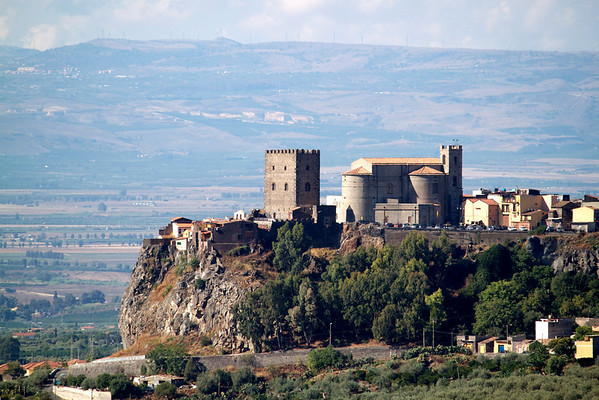English:
The Norman Castle in Motta Sant'Anastasia, Sicilia, Italy, is
built on top of a Volcanic Plug. Built in the late 11th century, it
takes perfect advantage of the defensive position afforded by the
steep cliffs of this particular plug.

The volcanic plug is estimated to have been formed during an
eruption about 550000 years ago. The surrounding softer rock then
eroded, leaving the harder lava tube protruding from the ground.
This rock was named "Motta" by the local inhabitants, and gives its
name to the town and castle which were built on its top
(Sant'Anastasia was later added to the town name in honor of the
town's patron saint).
From Wikipedia: A volcanic plug, also called a volcanic neck or
lava neck, is a volcanic landform created when magma hardens within
a vent on an active volcano. When forming, a plug can cause an
extreme build-up of pressure if volatile-charged magma is trapped
beneath it, and this can sometimes lead to an explosive eruption.
If a plug is preserved, erosion may remove the surrounding rock
while the erosion-resistant plug remains, producing a distinctive
upstanding landform. Examples include Shiprock, New Mexico; The
Nut, Australia; and the Pitons of Saint Lucia.
The coordinates provided are for a small parking area at the
base of the cliff, from where you can explore the geology of the
plug itself. The coordinates for the castle are N 37.511888 by E
14.971104.
To log this earthcache, you must email me the following:
1. An estimate of the height of the plug (heighest cliff
height).
2. The shape of the individual columns within the plug (how many
sides do they have).
3. OPTIONAL: A picture of your GPRr and/or yourself with the
volcanic plug and/or castle in the background.
Italiano: Tradotto con Google, il mio appologiez per eventuali
errori:
Il Castello Normanno di Motta Sant'Anastasia, Sicilia, Italia, è
costruita sulla cima di un plug vulcanica. Costruito alla fine del
secolo 11 °, ci vuole vantaggio perfetta della posizione difensiva
offerta dalla ripida scogliere di questo plug particolare.
La spina vulcanico si stima si siano formati durante un'eruzione
circa 550 mila anni fa. La roccia circostante più morbida poi
erose, lasciando il tubo di lava più sporgente dal suolo. Questa
roccia è stata chiamata "Motta" dagli abitanti locali, e dà il nome
alla città e del castello che sono stati costruiti sulla sua
sommità (Sant'Anastasia è stato poi aggiunto il nome della città in
onore del santo patrono della città).
Da Wikipedia: Una spina vulcanico, chiamato anche un collo
vulcaniche o collo lava, è una morfologia vulcanica creato quando
il magma si indurisce entro uno sfogo su un vulcano attivo. Al
momento di formare, una spina può causare una estremo accumulo di
pressione se magma volatile carica è intrappolato sotto di essa, e
questo a volte può portare ad una eruzione esplosiva. Se la spina è
conservata, l'erosione può rimuovere la roccia che circonda mentre
il plug-resistente all'erosione rimane, producendo un distintivo
landform onesto. Gli esempi includono Shiprock, New Mexico; L'
Dado, l'Australia e la Pitons di Santa Lucia.
le coordinate fornite sono per una piccola area di parcheggio
presso la base della rupe, da dove si può esplorare la geologia del
spina stessa. Le coordinate per il castello sono N 37.511888 da E
14.971104.
Per registrare questo earthcache, mi devi email al seguente:
1. Una stima della altezza della spina (scogliera panoramica di
Malcesine altezza).
2. La forma delle singole colonne all'interno della spina (come
da molte parti non hanno).
3. FACOLTATIVO:. Un'immagine del dispositivo GPRr e / o di te
stesso con il tappo vulcanico e / o il castello sullo sfondo.